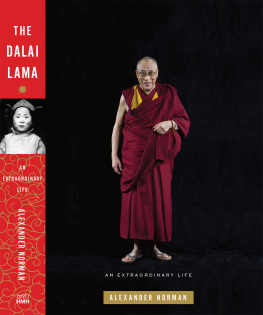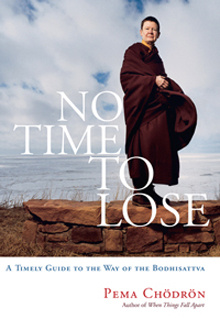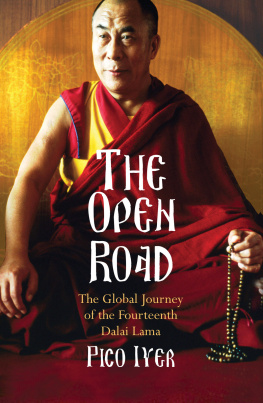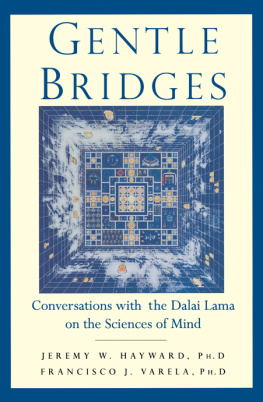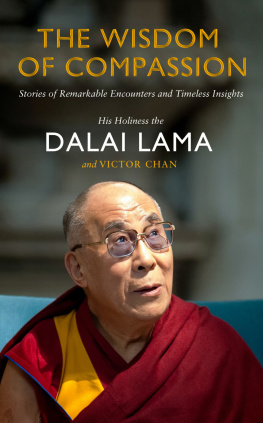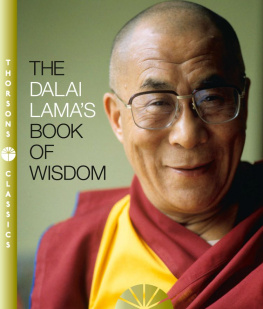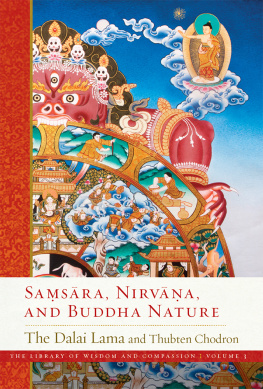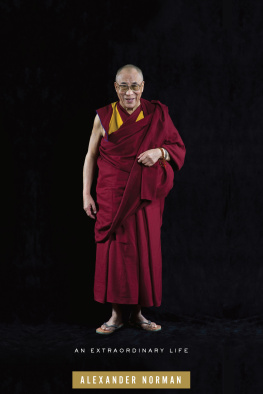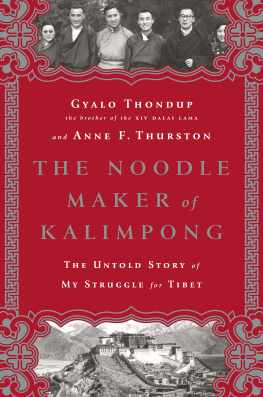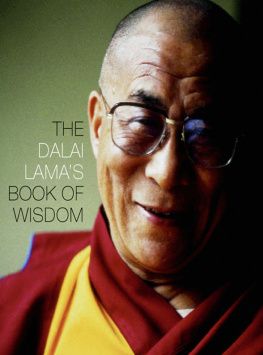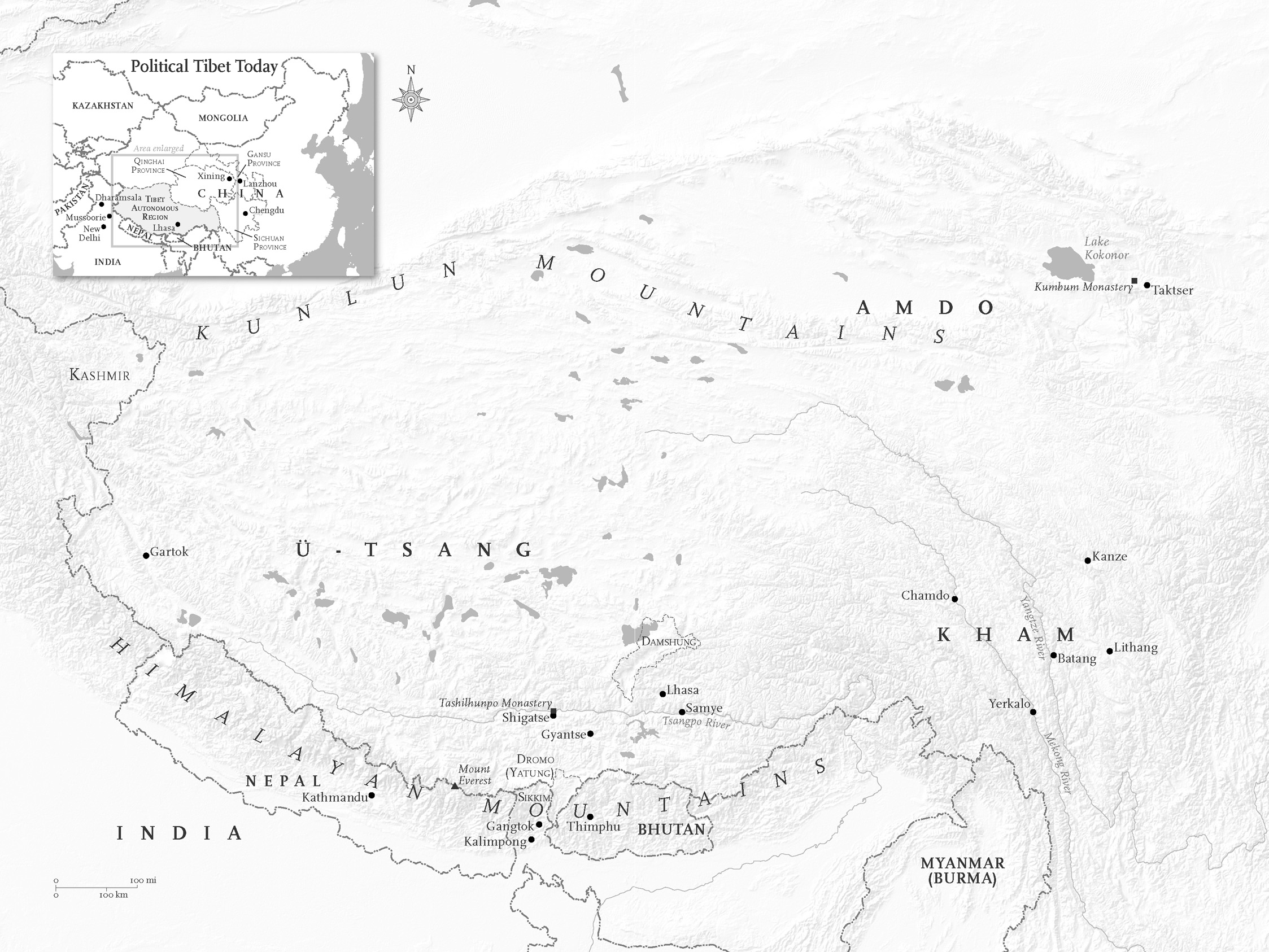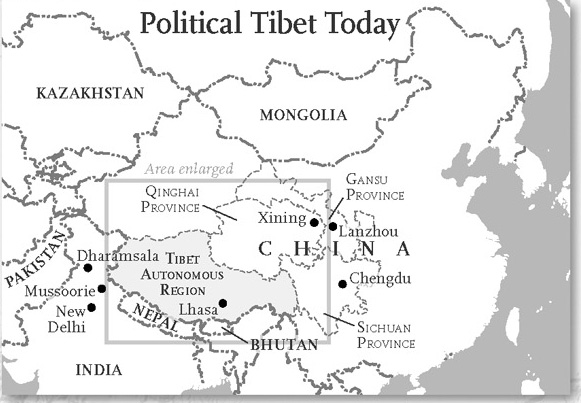Copyright 2020 by Alexander Norman
All rights reserved
For information about permission to reproduce selections from this book, write to or to Permissions, Houghton Mifflin Harcourt Publishing Company, 3 Park Avenue, 19th Floor, New York, New York 10016.
hmhbooks.com
Library of Congress Cataloging-in-Publication Data
Names: Norman, Alexander, author.
Title: The Dalai Lama : an extraordinary life / Alexander Norman.
Description: Boston : Houghton Mifflin Harcourt, 2020. | Includes bibliographical references and index.
Identifiers: LCCN 2019023278 (print) | LCCN 2019023279 (ebook) | ISBN 9780544416581 (hardcover) | ISBN 9780544416888 (ebook)
Subjects: LCSH : Bstan-dzin-rgya-mtsho, Dalai Lama XIV, 1935 | Dalai LamasBiography. | Tibet RegionBiography.
Classification: LCC BQ 7935. B 777 N 67 2020 (print) | LCC BQ 7935. B 777 (ebook) | DDC 294.3/923092 [ B ]dc23
LC record available at https://lccn.loc.gov/2019023278
LC ebook record available at https://lccn.loc.gov/2019023279
Cover design: Michaela Sullivan
Cover photograph Vincent J. Ricardel / Getty Images
Spine photograph Raghu Rai / Magnum Photos
Author photograph E. A. Norman
Map by Mapping Specialists, Ltd.
eISBN 978-0-544-41688-8
v2.0220
Excerpts from Freedom in Exile: The Autobiography of the Dalai Lama by Tenzin Gyatso. Copyright 1990 by Tenzin Gyatso, His Holiness, The Fourteenth Dalai Lama of Tibet. Reprinted by permission of HarperCollins Publishers and Little, Brown Book Group.
For my children:
M.R.N.
E.A.N.
T.F.H.N.
A Note on Language and Spelling
Most would agree that the Tibetan alphabet, in each of its forms, is highly attractive on the page. Its use in a nonspecialist book such as this is out of the question, however. Moreover, the standard (Wylie) method of transcription into European characters, although it renders the Tibetan accurately, produces almost equally baffling results for the general reader. Who would guess that bstan dzin rgya mthso (the name of the present Dalai Lama) is pronounced Tenzin Gyatso?
In view of this difficulty, I have given phonetics (often my own) for all Tibetan words and names. Where they occur more than once, I havein most casesincluded them in the glossary at the end, together with the correct Wylie transliteration.
It is also worth noting that Tibetan uses different tones, so words that are phonetically similar may have an entirely different meaning. Notoriously, the words for ice, shit, and fat are pronounced exactly alike, save for tonal register.
Cultural Tibet
Introduction
Waldorf Astoria Hotel, New York, August 1989
Striding up to Reception, I announce my purpose.
I am looking for Mr. Tenzin Tethong, private secretary to His Holiness the Dalai Lama.
Under my arm I am carrying the draft manuscript of the Dalai Lamas autobiography, Freedom in Exile, on which I have been working for the past several months.
The receptionist stares at me blankly. Perhaps it is my strong English accent.
Mr. De Whaaat? she demands in a slow drawl.
Three decades later, such a response is unimaginable. One of the worlds most instantly recognizable people, the Dalai Lama sells out sports stadiums from Sydney to So Paolo, from Oslo to Johannesburg. With around 20 million Twitter followers, the Dalai Lama has more than the pope, and his online presence continues to grow. He is a recipient of the Nobel Peace Prize, the Congressional Gold Medal, and the richest award of them all, the Templeton Prize for spiritual progress. He holds the freedom of cities and honorary degrees too numerous to list. His image adorns wristwatches and screensavers, while his Amazon page gives details of more than two hundred books crediting him as author. Sales of several individual titles run into the millions. Unquestionably, the Dalai Lama is one of the best-known and best-loved public figures of modern times.
Yet for all his latter-day superstardom, few know much about the Dalai Lama or about the culture he embodies. And of what is known, a great deal is misunderstood. For example, many people suppose that the Dalai Lama is a religious leadera sort of Buddhist pope. But unlike the pope, who claims authority over every priest and prelate in Christendom, the Dalai Lama has no jurisdiction over any other lama or monk. Neither is he the head of his own particular faith tradition, nor is he the leader of any of the subgroups within that tradition. In fact, he is not even abbot of the monastery of which he is a member. So when he says, as he often does, that he is just a simple Buddhist monk, the Dalai Lama is not just being characteristically modest. He is straightforwardly telling the truth. The Dalai Lamasof which the present one is the fourteenthhave only ever been simple Buddhist monks, even though the Great Fifth Dalai Lama was one of the most powerful men in Asia, and even though the Dalai Lamas have always been venerated by people far beyond the Land of Snows (as Tibetans often refer to their country).
From a political perspective, however, the Dalai Lamas have been anything but ordinary. Beginning with the Great Fifth, they have beenin theory at leasttemporal leaders of a people whose country is the size of western Europe, spanning over fifteen hundred miles from a border with Pakistan in the west to China in the east, and almost a thousand miles from Mongolia in the north to India, Nepal, and Burma in the south. But it is little known that in 2011, the present Dalai Lama renounced his claim to lead his people as head of state in favor of a democratically elected layman. As a result, the office of Dalai Lama is now purely a teaching office. This makes perfect sense, however: the word lama is the Tibetan translation of the Sanskrit word gurua spiritual guide.
Together with these misunderstandings, the Dalai Lamas image as smiling saint for all seasons fails to do justice either to the Dalai Lama as a person or to the tradition he represents. It neglects his extraordinary achievements in settling a diaspora community now a quarter of a million strong. It neglects how he has unified a people previously sharply divided along geographical, tribal, and sectarian lines. It neglects how, in so doing, he has opened up the institution of the Dalai Lama to all Tibetans in a way that it never was before. It neglects his political reforms. It neglects his remarkable attainments as a scholar-practitioner: he is unquestionably one of the most accomplished and learned masters of Vajrayana Buddhism to have emerged within the past century. It neglects the astonishing impact the Dalai Lama has had on the shape of the modern world. Above all, it neglects one of the most extraordinary cultures ever to have evolved on the face of the earth and the complex, often turbulent history that brought it into being.
In writing this book, therefore, I have sought above all to set the Dalai Lamas deeds in the context of the history and culture of the Tibetan tradition, and it is for this reason that I have shown in some detail the circumstances of how the regency that governed Tibet until the Dalai Lama was of age both came into being and came to an end. Without some understanding of what and where the Dalai Lama comes from, we are likely both to miss the scale of his accomplishments and to misconstrue the enormity of the challenges he has faced.

